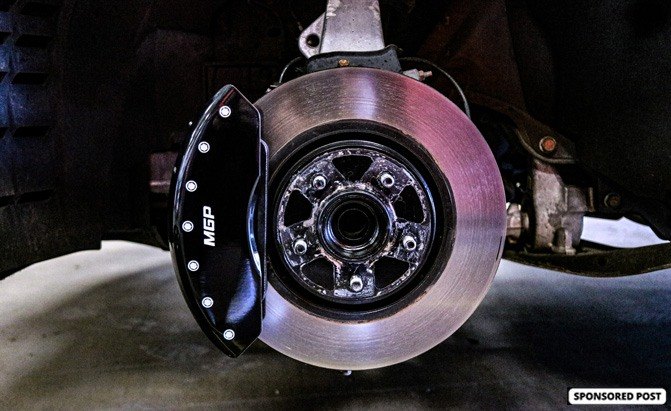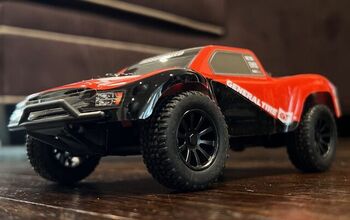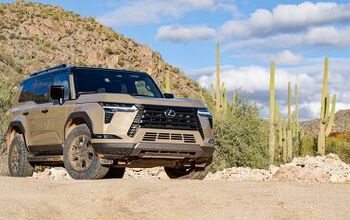Looking for an Easy Driveway DIY Project? Give Your Brakes an Upgrade With Caliper Covers
With everyone currently at home and countless car shows across North America canceled due to COVID-19, chances are pretty good that you’re looking for a project to keep you busy right about now. Luckily, there are plenty of automotive DIY projects for housebound gearheads to tackle from the comfort of their own garage. But if you want to keep your car looking sharp, and get it ready for cruising season, why not spend time upgrading the appearance of your brakes?
We’ve all seen the high-priced sports cars with the impressive, brightly colored brake calipers tucked away behind the wheels. Those big, attention-grabbing calipers have become a symbol of uncompromising performance in their own right, and jealousy of another owner’s bright, shiny Brembo or Wilwood calipers has become endemic among the car enthusiast population. Call it “brake envy.”
But if your car didn’t come straight from the factory with such nifty looking brakes, fear not, because there are ways to achieve a similar look without having to replace your calipers: using caliper paint and caliper covers. The only catch is, one of these methods is far more DIY-friendly than the other.
Because while painting your calipers may sound simple, it’s actually a much more complicated process than you might think. For those looking to add a pop of color behind their wheels, a set of covers from MGP Caliper Covers makes for a much easier, cleaner and less time-consuming end result. In order to understand why though, first let’s look at what’s actually involved in painting a set of brake calipers.
The Case Against Painting Your Brakes
When painting anything, cleanliness is the name of the game. That’s why professional car painting booths go to such great lengths to filter contaminants out of the air and keep dust and other particles to a minimum. You don’t have to go quite that far when painting your calipers at home, but you will have to clean your brakes thoroughly to achieve proper paint adhesion. Any amount of rust, brake dust, fluid, or anything else left behind on the bare metal can thwart your paint’s efforts to stick. That means you’ll need to spray them with a good degreaser and wipe them down before using a blasting them with a hand drill equipped with a wire brush attachment. (A dedicated can of brake cleaner can work wonders, but take care, as overexposure to brake cleaning fluid can damage certain plastic and rubber components.)
You can’t just use any old paint you have lying around the garage either; in order to do the job right and ensure repainting your calipers doesn’t turn into a weekly job, you need paint specifically made for the task. Caliper paint, which is capable of withstanding the extreme heat given off by your brakes, costs anywhere from $15 to $50. You’ll also need a pair of goggles and breathing mask.
Once you have the right tools, you have a basic, but crucial, choice to make: paint your brakes while they’re on the car, or remove them. Generally speaking, you’ll get better results with the brakes removed, and overspray won’t be such a concern. But you will have to disconnect the brake lines — releasing some toxic fluid that you’ll have to dispose of — and you’ll also need to refill and bleed the brake hydraulic system after your calipers are ready to go back on. Brake bleeding is absolutely crucial to their effective operation, so if that’s not a job you’ve done before, it’s best left to the pros.
Painting your calipers while they’re on the car is simpler, but still requires careful preparation: you’ll need to thoroughly tape off any parts you want protected from accidental overspray. Regardless of which method you choose, the full job will require at least five to six coats of paint, waiting 10 to 15 minutes between each application.
Finally, you’ll need to plan the job so your car has ample time to sit after painting. Recommended curing time can last anywhere from overnight to a full 24 hours, so if you have any immediate plans, it’s best to reschedule or arrange for a backup ride.
The Case for Caliper Covers
As you can see, there’s a lot of room for error in painting your brakes. No matter how meticulous you are, contaminants can linger on the surface, ruining the paint’s ability to bond over certain areas. Dust in the environment can stick into your top coat and spoil an otherwise spotless finish. And even if everything does go off without a hitch, no DIY paint job can match the durability and chemical resistance of a factory coating — meaning you can expect to have to clean and reapply your caliper paint every few months to keep the finish looking right.
Contrast that to a set of MGP Caliper Covers, which come with a crisp, factory finish and install directly over your brakes for perfect results, every time. They’re made from 6061-T Aerospace Grade Aluminum – no plastic in sight – meaning they can withstand high heat and other abuse without warping or chipping. Plus, they’re fully customizable, available with a vast array of engraving and color options. (Good luck engraving those painted calipers yourself, unless you’re an absolute artist with a rotary tool…)
Even more importantly though, caliper covers are much, much simpler to apply, requiring only basic hand tools, 10 easy steps, and maybe an hour of your time. Yes, one hour. It takes more effort to jack up your vehicle and remove the wheels than it does to actually install the covers.
Just check out this video to see for yourself:
For a full, step-by-step walkthrough of the install process, click here.
The Bottom Line
At the end of the day, both caliper paint and caliper covers represent a substantial upgrade in appearance over your dull factory brake calipers. Ultimately though, MGP Caliper Covers make a lot more sense – both as a quick-and-easy driveway DIY project, and for the long-term look and performance of your brakes.
Since MGP Caliper Covers install directly over your existing brake calipers, the finished result looks much cleaner, smoother, and more professional than you’re ever going to be able to manage with a spray can and a spare afternoon. Better yet, it also comes with a three-year warranty — unlike your DIY paint job, which is backed only by your confidence in your own work. Combine that with a broader range of design choices — with custom color options and engraving designs that include licensed OEM logos and scripts, and even an option to upload your own – and the choice is clear.
So when it comes to your next driveway project, skip the caliper paint and go straight to CaliperCovers.com instead. Some DIYs just aren’t worth it.
More by AutoGuide.com Staff





































Comments
Join the conversation